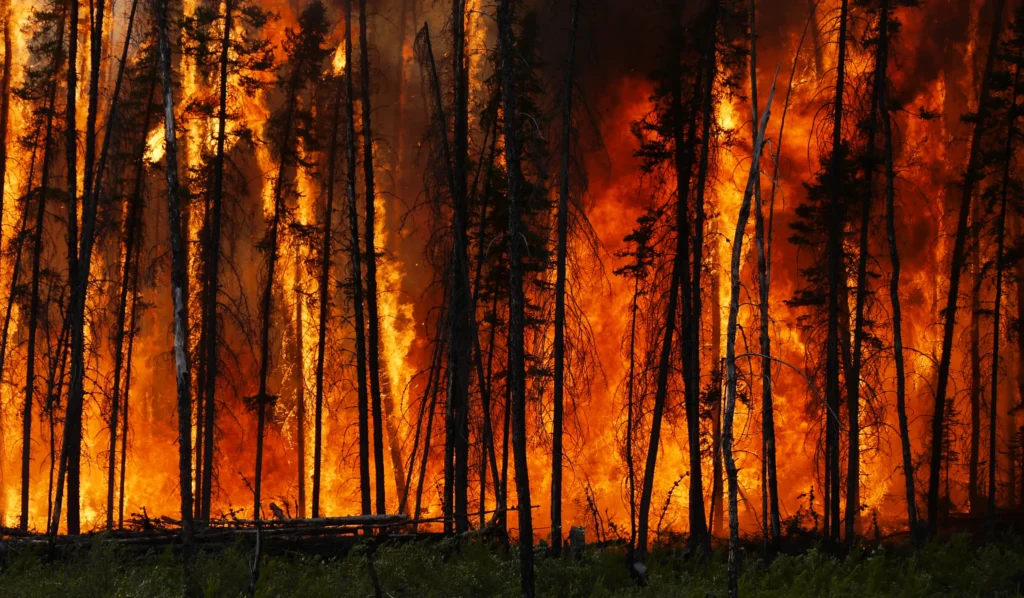Approximately 17,000 people have been forced to evacuate as massive fires rage across hundreds of thousands of acres in Canada.
In addition to posing a threat to Canadian communities, the fires in Saskatchewan and Manitoba are being fueled by rising temperatures, strong winds, and dry air. Additionally, they are predicted to produce poor air quality by May 30 by bringing thick smoke into the northern US.
Scott Moe, the premier of Saskatchewan, issued a warning that bad weather could make matters worse in the days ahead.
Let’s look at the situation!
How bad are the wildfires in 2025?
In Canada, there are many wildfires (big fires in forests). The people who take care of these fires say the danger level is now at Level 5, the highest level.
Right now (July 18), there are 561 wildfires burning in Canada. Out of these, 69 are out of control.
Some places, like Manitoba, the Northwest Territories, and Yukon, had the most fires this year, but British Columbia and Alberta have the most fires that firefighters are working hard to stop.
Since January, more than 5.5 million hectares of land have burned. That’s more than double the usual amount in the last 10 years.
Why is this happening?
- The weather has been hotter than normal.
- There has been less rain in many areas.
- Some places are very dry (drought).
All of this makes it easier for fires to start and spread.
These fires don’t just hurt the forests. They also:
- Make the air hard to breathe.
- Put people’s safety at risk.
- Cost a lot of money to fix.
Last year, the damage from wildfires cost more than $8.5 billion. Experts say that by the year 2040, the money needed to fight fires could be twice as much because fires are getting worse.
What effects does smoke from wildfires have on health?
PM 2.5, a type of fine particle found in wildfire smoke, can enter the bloodstream and travel deep into the lungs. Short-term exposure can aggravate asthma, cause bronchitis, and cause other health problems.
Residents of the impacted areas, particularly those in higher-risk categories such as children, the elderly, pregnant women, and those with heart or lung disorders, have been cautioned by officials in both Canada and the United States to modify their outdoor activities.
According to the C.D.C., people who have other long-term illnesses, such as diabetes and chronic kidney disease, are also more likely to become ill from smoking.
The government also displays the local air quality index, which can assist you in deciding whether to spend less time outside.
Why did the wildfires occur?
Lightning is the primary cause of most fires in Canada.
The natural resources department of Canada discovered in 2023 that 93 percent of the nation’s total wildfire area was caused by lightning-sparked fires, with the remaining 7 percent burning due to human activity.
The remoteness of many fire-burning areas makes it impossible to use forest management practices like prescribed burns and tree and bush removal to reduce the intensity of the fires.
Are wildfires impacted by climate change?
Researchers have discovered that the dry and windy conditions that contribute to the intensity of wildfires are being exacerbated by climate change.
Professor Michael Waddington of McMaster University in Hamilton, Ontario, focuses on the relationship between forests and wildfires. He claimed that Canadian forests were becoming a tinderbox due to climate change.
Even though U.S. emissions in 2022 were marginally lower than in 1990, transportation and electricity production remain significant contributors.
In 2020, during his first term, and again in January of this year, just months after winning reelection, President Trump withdrew the United States from the Paris Climate Accord.
Expectations in the United States
Forecasters at FireSmoke Canada predict that smoke from the fires will begin to spread over much of the United States in the Midwest.
According to the state’s Pollution Control Agency, the effects of the fires started to be felt in Minnesota on May 29. By evening, poor air quality was predicted for Upper Wisconsin and the Upper Peninsula of Michigan.
By early Saturday morning, smoke is predicted to reach the Carolinas and the Ohio Valley on May 30.
Authorities in Minnesota issued a warning about dangerously high exposure levels to fine particles from the wildfires. Breathlessness, heart attacks, and strokes are among the symptoms.
Conclusion:
The wildfire season in Canada in 2025 is a wake-up call as much as a fire story. Even if the clouds eventually clear, the following questions still need to be answered: Are we ready to deal with a year-round fire season in the future? When smoke turns into background noise, can we manage the long-term harm and public health effects?
There is no doubt that we must address wildfires as climate crises rather than seasonal emergencies. Because not only the forests, and not just Canada, are at risk as we watch our communities and skies burn.
FAQs
Q1: What is Canada’s primary cause of wildfires?
Lightning strikes are the cause of just under half of all wildfires in Canada, despite accounting for over 81% of the total area burned.
This is primarily due to two factors: Lightning-caused fires frequently occur in isolated locations where property, timber resources, and human life may not be affected.
Q2: Why is Canada unable to manage wildfires?
Prescribed burns and tree and bush removal are two forest management strategies that can reduce the intensity of fires in many remote areas.


